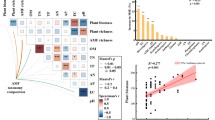Abstract
To examine the natural colonisation of native mangrove species into remediated exotic mangrove stands in Leizhou Bay, South China, we compared soil physical–chemical properties, community structure and recruitments of barren mangrove areas, native mangrove species plantations, and exotic mangrove species—Sonneratia apetala Buch.Ham—between plantations and natural forest. We found that severely degraded mangrove stands could not regenerate naturally without human intervention due to severely altered local environments, whereas some native species had been recruited into the 4–10 year S. apetala plantations. In the first 10 years, the exotic species S. apetala grew better than native species such as Rhizophora stylosa Griff and Kandelia candel (Linn.) Druce. The mangrove plantation gradually affected soil physical and chemical properties during its recovery. The exotic S. apetala was more competitive than native species and its plantation was able to restore soil organic matter in about 14 years. Thus, S. apetala can be considered as a pioneer species to improve degraded habitats to facilitate recolonisation by native mangrove species. However, removal to control proliferation may be needed at late stages to facilitate growth of native species. To ensure sustainability of mangroves in South China, the existing mangrove wetlands must be managed as an ecosystem, with long-term scientific monitoring program in place.


Similar content being viewed by others
References
Arnold K (1986) Methods of soil analysis. Part I. Physical and mineralogical methods, 2nd edn. Soil Science Society of America, Madison, WI
Bosire JO, Dahdouh-Guebas F, Kairo JG, Koedam N (2003) colonisation of non-planted mangrove species into restored mangrove stands in Gazi Bay, Kenya. Aquat Bot 76:267–279
Chen YJ, Liao BW, Zheng SF et al (2004) Dynamics and species-diversities of artifical Sonneratia apetala, Sonneratia caseolaris and Kandelia candel communities. Chin J Appl Ecol 15:924–928
Ellison AM (2000) Mangrove restoration: do we know enough? Restoration Ecol 8:219–229
FAO (1994) Mangrove forest management guideline. FAO, Rome
Field CD (1999) Remediation of mangrove ecosystems: an overview. Mar Pollut Bull 37:383–392
Han WD, Gao XM, Teunissen E (2001) Study on Sonneratia apetala productivity in restored forests in Leizhou Peninsula, China. J For Res 12:229–234
Han WD, Gao XM, Lu CY, Lin P (2003) Mangrove flora and associations of Leizhou Peninsula. Guihaia 23:127–132
Zan QJ, Wang BS, Wang YJ, Ming-Guang L (2003) Ecological assessment on the introduced Sonneratia caseolaris and S. apetala at the Mangrove Forest of Shenzhen Bay. China. Acta Bot Sin 45:604–612
Kathiresan K, Bingham BL (2001) Biology of mangroves and mangrove ecosystems. Adv Mar Biol 40:81–251
Kovacs JM (1999) Assessing mangrove use at the local scale. Landsc Urban Plan 43:201–208
Krebs CJ (1985) Ecology: the experimental analysis of distribution and abundance, 2rd edn. Harper & Row, New York
Lewis RR III (2005) Ecological engineering for successful management and restoration of mangrove forests. Ecol Eng 24:403–418
Li ZQ (2003) Orientation and management strategy of mangrove forest in the forestry development of Guangdong. Prot For Sci Technol 56:36–38
Li Y, Zhen DZ, Chen HX et al (1998) Preliminary study on introduction of mangrove Sonneratia apetala Buch-Ham. For Res 11:39–44
Liang SC, Liang MZ, Wu YL, Zan QJ, Wang YJ, Xie Q (2005) Analysis of the spatial structure of natural Sonneratia caseolaris + S. apetala forest in Futian, Shenzhen. Guihaia 25:393–398
Liao BW, Zheng SF, Chen YJ et al (2004) Biological characteristics and ecological adaptability for non-indigenous mangrove species Sonneratia apetala. Chin J Ecol 23:10–15
Liao BW, Li M, Zheng ZF et al (2005) Niches of several mangrove species in Dongzhai harbor of Hainan island. Chin J Appl Ecol 16:430–407
Lin ZL (1999) Current situation and conservation of mangrove forest in Guangdong. Ocean Inf 6:25–27
Lin ZD, Liu HM (2003) Protection and management countermeasures for mangrove resource in Guangdong province. Central South For Invent Plan 22:35–38
Lin KY, Zhang QM, Ren H (2006) Mangrove resource and sustainable development at Zhanjiang. Ecol Sci 23:23–29
Lugo AE (1999) Mangrove forests: a tough system to invade but an easy one to rehabilitate. Mar Pollut Bull 37:427–430
Macintosh DJ, Ashton EC, Havanon S (2002) Mangrove remediation and intertidal biodiversity: a study in the Ranong mangrove ecosystem, Thailand. Estuar Coast Shelf Sci 55:331–345
Robert L, Morlang A, Gorman L (1997) Monitoring the coastal environment. Part II. Sediment sampling and geotechnical methods. J Coast Res 13:308–330
Snedaker SC (ed) (1984) The mangrove ecosystem: research methods. UNESCO, Paris
Wang BS, Liao BW, Wang YJ et al (2002) Mangrove forest ecosystem and its sustainable development in Shenzhen Bay. Science, Beijing
Wartel S, Barusseau J, Cornand L (1995) Improvement of grain size analyzes using the automated SEDIGRAPH 5100. Document 80. KBIN, Brussels, Belgium
Wu ZH, Cai JX, Ye XB (2000) Analysis on effects of introduction and popularization of Sonneratia apetala. Guangdong For Sci Technol 16:6–10
Zan QJ, Wang YJ, Liao BW et al (2001a) The structure of Sonneratia apetala + S. caseolaris– Kandelia candel mangrove plantations of Futian, Shenzhen. For Res 14:610–615
Zan QJ, Wang YJ, Wang BS (2001b) The ecological effects of Sonneratia apetala + S. caseolaris mangrove plantations of Futian, Shenzhen. Acta Sci Natl Univ Sunyatseni 40:72–76
Zedler JB (ed) (2000) Handbook for restoring tidal wetlands. CRC, London
Acknowledgements
We thank Drs. Rui-Jiang Wang and Hong-Fu Wan of the South China Botanical Garden and all staff of the Administration of Zhanjiang Mangrove National Natural Reserve for field assistance during the study. We also thank anonymous reviewers for their valuable comments on the early version of the manuscript. This project was supported by the Knowledge Innovation Program of the Chinese Academy of Sciences (KSCX2-SW-132), Natural Science Foundation of China (30670370, 30600072) and the Guangdong Sci-Tech Planning Project (2005B60301001).
Author information
Authors and Affiliations
Corresponding author
About this article
Cite this article
Ren, H., Jian, S., Lu, H. et al. Restoration of mangrove plantations and colonisation by native species in Leizhou bay, South China. Ecol Res 23, 401–407 (2008). https://doi.org/10.1007/s11284-007-0393-9
Received:
Accepted:
Published:
Issue Date:
DOI: https://doi.org/10.1007/s11284-007-0393-9




